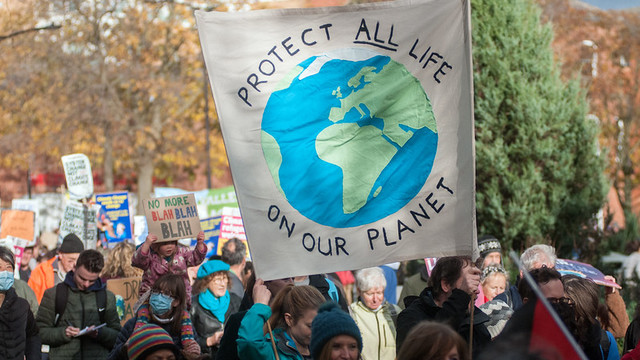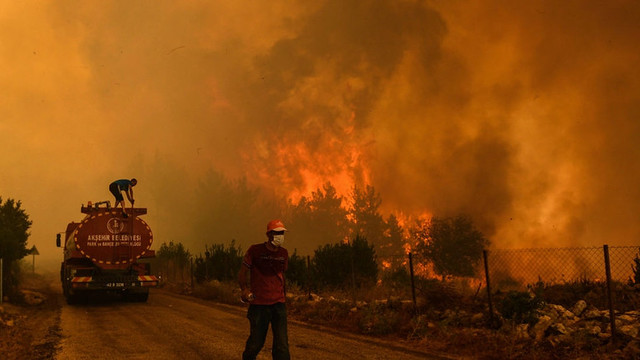Biden’s climate summit needs to show leadership for the most vulnerable – here’s how
All eyes are on the United States this week, as new President Joe Biden hosts 40 heads of state at his virtual Leaders Summit on Climate. Action, not statements, are needed this year, and vulnerable countries articulated a set of clear actions to overcome challenges on adaptation, resilience and loss and damage at the recent UK Climate and Development Ministerial meeting. How can Biden continue the momentum for these solutions through his summit? Andrew Norton provides some insights.


This week, US President Biden invites 40 world leaders to participate in the virtual Leaders Summit on Climate (Photo: Gage Skidmore via Flickr, CC BY-SA 2.0)
A new era in US climate politics will begin this week, as US President Joe Biden hosts the much-anticipated Leaders Summit on Climate on April 22-23. This follows a surge in US climate diplomacy in recent months, and speculation that the US will announce a new emissions reduction target at the summit. Alongside the more ambitious emissions reduction target announced by the UK on Tuesday, this will set a positive tone for mitigation discussions at the summit this week.
The agenda for the summit covers many important topics – emissions reductions, energy transition, transformational technologies and the role of nature-based solutions.
It’s a big agenda, and while these are deserving topics, there needs to be a much stronger focus on adaptation, loss and damage, and climate finance for both these issues. World leaders cannot drive transformative climate action without tackling these issues alongside mitigation.
Adaptation, loss and damage and the finance to address them featured strongly at the UK-hosted Climate and Development Ministerial meeting in March. The ministerial-level event brought together countries and multilateral institutions to identify practical steps to unlock critical adaptation and resilience challenges, and the UK COP26 president has made public statements (subscription required) expressing strong commitments to progressing the solutions raised.
While most wealthy country statements fell short, leaders from the most climate vulnerable countries stood out – for proposing strong, targeted and clear solutions. Their proposals have strong backing, including from government officials and civil society experts who co-developed them.
Biden’s climate summit needs to help turn these solutions into action.
From statements to action
Biden is keen to ensure his summit leads to tangible action. Drawing on the solutions identified by the most vulnerable countries at the ministerial meeting, there are three specific ways the summit can galvanise action on climate finance, local adaptation and loss and damage.
1. Scale-up adaptation funding and support the new task force on access to finance
There is still a major gap in adaptation financing. Only 20% of climate finance supports adaptation activities, and only 15% and 2% of this supports least developed countries (LDCs) and Small Island Developing States respectively. This week’s US climate summit can reinforce calls from vulnerable countries and the UN Secretary-General to scale up adaptation funding and ensure at least 50% of public climate finance supports adaptation and resilience.
Further, the UK has committed to work with Fiji and other countries to initiate a new task force on access to finance. The summit can show solidarity with vulnerable countries by highlighting the urgent need for the task force to address the following priorities they have identified:
- Developing a clear and shared definition of climate finance and its function to enable transformation of systems and to experiment and take risks
- Harmonising, streamlining and simplifying procedures to improve direct access to climate finance that is aligned across the multilateral funds
- Moving to 'business-unusual' approaches, where solutions are developed by countries and communities and taken to scale
- Shifting to longer-term commitments for truly transformative change, and providing predictable and patient finance
- Focusing on grants, and not loans, to fund adaptation
- Greater transparency of climate finance, including better quality data connected to detailed project information, and clear reporting rules
- Set rules for international intermediaries to build national and local institutional capacity on climate finance, thus working themselves out of a job, and
- Setting targets for delivering finance at the local level, and according to the principles for locally led adaptation action.
The US climate summit should maintain the pressure to ensure the workplan for the task force, to be released by the Petersberg Climate Dialogue in May, reflects these priorities from vulnerable countries, and that the membership of the task force and external engagement includes strong representation from the vulnerable countries, smaller and more progressive donors as well as the G7.
It should also look at how the Major Economies Forum on Energy and Climate, which the US is expected to reinvigorate at the summit, can help address these issues.
2. Push for locally led adaptation
The world needs to deliver climate finance on different terms. Meaningful engagement with Indigenous Peoples and local communities, women, youth and other local actors is key to unlocking strong climate action, especially for adaptation. Giving resources and agency to local stakeholders to lead in adapting to climate change gives communities on the frontline of climate impacts a voice in decisions that directly affect their lives and livelihoods.
There is growing momentum for locally led adaptation, another solution highlighted at the ministerial event by vulnerable countries. These countries recognise the importance of whole-of-society actions that respond effectively to a range of contexts by enabling adaptation that draws on local and traditional knowledge.
The US climate summit can reinforce this, by calling on countries, climate finance providers, intermediaries and other climate partners to sign up to the principles for locally led adaptation action. The eight principles, already endorsed by more than 40 governments and institutions, will help to ensure that local communities have the resources and agency to lead sustainable and effective adaptation to climate change at the local level.
Vulnerable countries can also sign up, but adaptation will not be as effectively delivered at the local level if wealthy countries and climate finance providers don’t commit also.
3. Maintain pressure for action on loss and damage
At the ministerial event, vulnerable countries also raised frustrations that loss and damage has been on the climate change agenda for a long time, but little progress has been made. They called for stronger financial and technological support for loss and damage and highlighted the need to break the deadlock in negotiations.
These calls aren’t new. The Least Developed Countries (LDC) Group and the Alliance of Small Island States (AOSIS) are advocating the need to prioritise loss and damage in the UNFCCC process. The Youth Coalition on loss and damage is also emerging as a powerful voice in this space.
Animations recently co-produced by IIED with partners in the Solomon Islands, Sierra Leone and Rwanda highlight the need for urgent action on loss and damage, noting its crucial importance for vulnerable communities.
A chorus of voices is calling on wealthy governments to recognise the mutual gains that can be made from addressing loss and damage, for example through more resilient global supply chains, reduction of climate-induced migration and enhanced security.
Support for action on loss and damage can be strengthened by developing a shared vision, by identifying good practice and providing effective assistance. Further, the Santiago Network for loss and damage, once operational, can play a critical role in progressing this shared vision and catalysing support.
Leaders at the summit should stand with vulnerable countries and recognise that both adaptation and loss and damage are just as important as mitigation, given the greenhouse gases already emitted and the existential threat the poorest countries face in tackling climate change. Avoiding these discussions, regardless of how difficult or sensitive they are, is no longer an option.
Where to from here?
There are many moments this year where leaders will gather to talk about major international issues – the G7, G20, COP26 and more. In the shadow of a pandemic, 2021 cannot be another year of talk and no action for climate change.
As shown at the ministerial meeting, vulnerable countries are clear about the solutions needed to push forward on climate action. For the US climate summit to be relevant and truly galvanise action on climate change, it must keep momentum for these priorities and show strong solidarity with those who have done the least to create this crisis.



